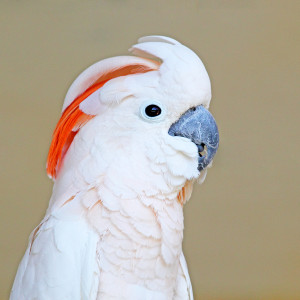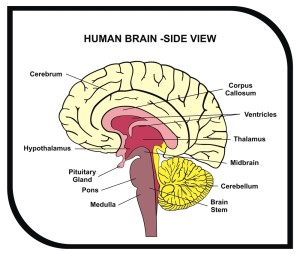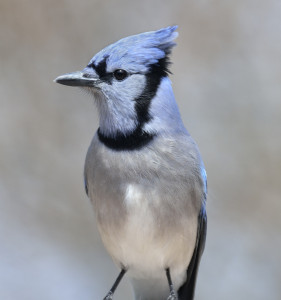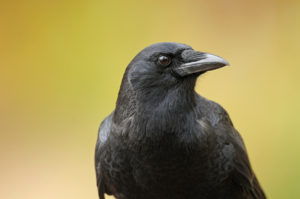 Many birds have remarkable abilities, far greater than has been considered possible with their small brains. Songbirds are a large category of thousands of species of birds that have advanced vocal learning ability, similar to humans. (See post on vocal learning similarities between humans and songbirds). Some of these bird species are among the most remarkable intelligent animals on earth—crows, jays, magpies, parrots and ravens. Recently, it has become clear that crows are so intelligent that they have unique capacities that only humans share among all animals on earth. What is quite remarkable is that they have these capacities with very different small brains that evolved separately from humans for up to fifty million years.
Many birds have remarkable abilities, far greater than has been considered possible with their small brains. Songbirds are a large category of thousands of species of birds that have advanced vocal learning ability, similar to humans. (See post on vocal learning similarities between humans and songbirds). Some of these bird species are among the most remarkable intelligent animals on earth—crows, jays, magpies, parrots and ravens. Recently, it has become clear that crows are so intelligent that they have unique capacities that only humans share among all animals on earth. What is quite remarkable is that they have these capacities with very different small brains that evolved separately from humans for up to fifty million years.
This post will discuss some of the recent research on just how intelligent crows are, as well as some of the current views of the comparison of human and crow brains. Crows have complex inner lives using advanced abstract concepts and extreme personal awareness. First, there is a brief summary of bird intelligence from other posts—for more details see previous posts for details see post on similarities of humans and bird vocal learning and mourning.
Summary of Bird Intelligent Abilities
Crows

From Accipiter Crows remember people and cars for years and have metacognition and counting. They use tools better than most primates. They upgrade tools, molding wire into a hook and use three different tools for one task, more than chimps. They build hooked stick tools very carefully observing each feature of the tool before use to make sure it can help with prey. They hide them for future use.
- Crows are able to use analogies—solving higher-order, relational-matching tasks spontaneously. Crows understand that dropping stones in a water bottle connected with a tube raised the water level at a distance to get a floating piece of meat.
Other Birds
 Cockatoos rapidly perform five sequential steps to unlock a cage—remove a pin, screw and then bolt; turn a wheel 90 degrees; and shift a latch. Birds who watched the first attempt did all steps immediately and never forgot them for years. Recently, an entire flock of jays sat still for a fallen comrade, mourning for 48 hours without any foraging for food.
Cockatoos rapidly perform five sequential steps to unlock a cage—remove a pin, screw and then bolt; turn a wheel 90 degrees; and shift a latch. Birds who watched the first attempt did all steps immediately and never forgot them for years. Recently, an entire flock of jays sat still for a fallen comrade, mourning for 48 hours without any foraging for food.- Alex the parrot showed skills for arithmetic and advanced language. He invented new words—“bannery” for a combination of banana and cherry. He could count, add to 8 and understood zero. Just before he died, he told Dr. Pepperberg “You be good. I love you.” Parrots understand sharing, relating actions in the near time to human’s future.
- Birds use smells for navigation of thousands of miles. Birds take gyroscope readings at takeoff and compare them to their home readings.
- Birds store seeds in up to thousands of different places and remember these for hours and months. Clark’s nutcracker stores 5000 seeds in different caches and then gets them 9 months later.
 Bowerbirds use advanced perspective, actively selecting specific material for their nests that hide them against the background. They choose to match the colors. They deliberately manipulate perception of color.
Bowerbirds use advanced perspective, actively selecting specific material for their nests that hide them against the background. They choose to match the colors. They deliberately manipulate perception of color.- Ravens can understand other bird’s rank by observation. Ravens have very complex societies with shifting political alliances.
- Pigeons memorize routes by using landscape properties and landmarks.
- Songbirds learn songs, grammar and syntax from a mentor, like humans, and then practice them. Songbirds name their children, who are known by that sound for life. Their use of different tweets is more complex than monkey’s signals. Songbirds prefer singing in harmonic series similar to humans even though anatomically they could sing many other ways. They choose to sing in a particular key and with consonant intervals, octaves, fifths and fourths like humans. Songs are used for mating and defending territory
- Songbirds use different language dialects like humans.
Unique Bird Brains
Two critical parts of the the human cortex develop from different fetal stem cells—the striatum (habit and movement memory) and the cortex for decision making, and complex analysis of sensory motor function. The striatum is very important in learning skills, particular motor skills including vocal learning and songs.
Birds were thought not to have a cortex at all. Most higher order neurons were considered to be like the striatum. But, now it is shown that what appears to be the bird’s telencephalon is equivalent to a cortex derived from similar types of stem cells during fetal life. A similar type of cell becomes the mammal’s cortex and birds’ dorsal ventricular ridge (DVR). The DVR was discussed in detail in the previous post on songbird vocal learning. Very few of these neurons are from the types of cells in the striatum.
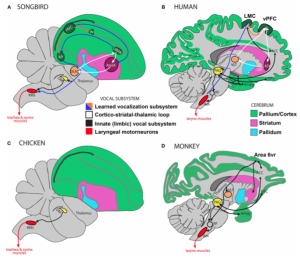 While there are some organizational similarities with humans, the birds’ brain structure is quite different. Different unique structures surround the DVR. One view is that a dorsal region becomes the neocortex in mammals for vision, touch and position sensation, and a similar region forms cortex-like regions in birds called the Wulst. The lateral region becomes smell regions in humans, and piriform cortex in birds.
While there are some organizational similarities with humans, the birds’ brain structure is quite different. Different unique structures surround the DVR. One view is that a dorsal region becomes the neocortex in mammals for vision, touch and position sensation, and a similar region forms cortex-like regions in birds called the Wulst. The lateral region becomes smell regions in humans, and piriform cortex in birds.
In humans the neo cortex is in the back and in birds this cortex-equivalent is in the front along with the DVR. Both the human cortex and the Wulst perform many of the same functions in different ways. Mammals have six layers in the cortex with lots of connections; below there are deep structures with physical functions and immediate response to external stimulation (striatum, thalamus, midbrain, brainstem). Birds, instead of cortical layers, have neuronal nuclei with fewer connections and less layers. In owls, who have incredible visual acuity, the Wulst for primary processing of vision has more layers that are slightly similar to human cortex.
 Both humans and birds have three main visual circuits. Of the three, different circuits are primary in birds and mammals. It is striking that although these two brains developed independently in evolution with no real shared common ancestor, the color and motion processing are quite similar in different structures. It is an interesting question as to why they developed differently with the same circuit functions.
Both humans and birds have three main visual circuits. Of the three, different circuits are primary in birds and mammals. It is striking that although these two brains developed independently in evolution with no real shared common ancestor, the color and motion processing are quite similar in different structures. It is an interesting question as to why they developed differently with the same circuit functions.
There are, also, similarities in hearing, motor and touch sensation pathways. Mammals have functions neatly in columns that are very close to each other for efficient wiring. In songbirds, who are the only other creatures with the same type of vocal learning, they, also, are clustered in columns. The stabilizing optical system is more complex for flying in 3D.
The nuclei in fact are much more organized than previously thought but in different ways. Recent study of the pigeon shows nuclei with similar functions sharing connections and hubs as humans do in the layers of the cortex.
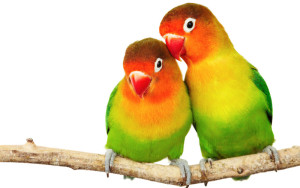 The human pre frontal cortex (PFC) is particularly important for advanced thinking. In mammals, understanding other’s minds, decision-making, reward learning, emotional and social learning and insight need PFC regions. Very recently, bird genetic studies show that a region called nidopallium caudolaterale (NCL) is involved in all of these functions. It is highly connected to many other nuclei. It has dopamine 1 and 2 neurons connected with striatum.
The human pre frontal cortex (PFC) is particularly important for advanced thinking. In mammals, understanding other’s minds, decision-making, reward learning, emotional and social learning and insight need PFC regions. Very recently, bird genetic studies show that a region called nidopallium caudolaterale (NCL) is involved in all of these functions. It is highly connected to many other nuclei. It has dopamine 1 and 2 neurons connected with striatum.
In fact, the recent research shows that birdbrains actually do have advanced organization into hubs and circuits between brain nuclei (humans between layers of cortex and birds between nuclei). Therefore, the current understanding is that the architecture is different, but some organizational principles are the same. Birds and humans are surprisingly similar in many studied capacities.
Crows Unique Among Birds
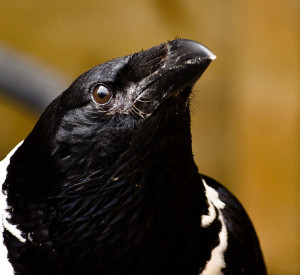
Songbird’s brains have brain circuits that identify a particular song. They have circuits to produce different songs in different circumstances. In crows, the NCL is essentially their PFC and is much larger than other birds. Crows have a larger brain than other birds, while still very small compared to humans.
Pigeons learn visually for each specific example. Their brain activity mostly occurs in the delay after understanding something, linking this to rewards. A special brain structure was recently found in parrots. It has a core and shell for vocal learning. Neurons in the shell are critical for advanced movement behavior.
Crows learn rules and abstractions that are used in a variety of ways. The crow’s response is different responding to more complex abstractions and rules in the response. The larger crow NCL is an intermediary after the stimulus where these complex abstractions and rules uniquely become part of the response. Special regions fire if an error is about to be made to warn. Also, activity occurrs long after the stimulus, possibly placing the circumstances in memory before a decision is made.
Perhaps it can be said that the pigeon NCL is similar to primates, and the crow to humans.
In comparison to crow abilities, human children know what-where-when from 4 to 5 years of age, making hooked tools only at age 8 and only in half of the children. Water displacement is understood only at age 8.
Crow Cognition
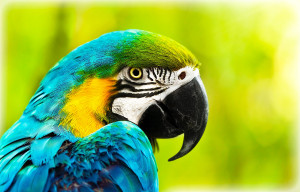 More study has been done on crows’ higher cognitive capacities than any other bird. Crows are part of the songbird group with advanced vocal learning. Parrots have even more advanced language skills and can both imitate words and create their own. Parrots, also, have complex social relationships with other birds and with humans. But, crow intelligence is unparalleled among all birds.
More study has been done on crows’ higher cognitive capacities than any other bird. Crows are part of the songbird group with advanced vocal learning. Parrots have even more advanced language skills and can both imitate words and create their own. Parrots, also, have complex social relationships with other birds and with humans. But, crow intelligence is unparalleled among all birds.
Three birds have been most studied as models of general learning—pigeons, songbirds and chicks. Pigeons are widely studied for the navigation, homing and visual abilities. Pigeons are extremely good at vision and can fly between very close buildings at high speeds. Pigeons have brain regions equivalent to the PFC.
Chicks are specially studied for learning, memory and imprinting. Even very young chicks have advanced abilities related to visual space and social learning and awareness. See post on vocal learning for the details about songbirds.
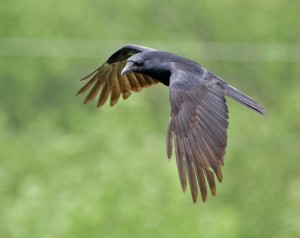 One study of advanced cognition, called object permanence, is the ability to remember of the existence of an object when it cannot be observed by sight, sound, touch, smell or any other way. This ability exists in crows, parrots and apes. These species, also, have reasoning from causes, flexibility, thinking ahead and imagination. But, only crows are able to use these to plan ahead in great detail.
One study of advanced cognition, called object permanence, is the ability to remember of the existence of an object when it cannot be observed by sight, sound, touch, smell or any other way. This ability exists in crows, parrots and apes. These species, also, have reasoning from causes, flexibility, thinking ahead and imagination. But, only crows are able to use these to plan ahead in great detail.
Crows are now thought to have such advanced cognitive ability that the only other species to have these capacities are humans. Crows, uniquely, remember and plan ahead. They are incredibly capable of using tools and problem solving. They hide these tools for later use like any workman. They understand advanced social relationships in the past and future.
Crows’ Mental Time Travel
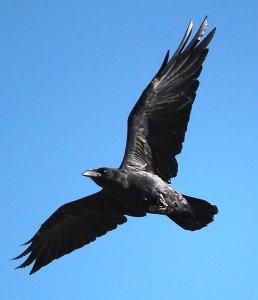 Since we don’t understand the inner world of animals, it is impossible to know how many have human mental capacities. But with intensive study, crows have been found to understand mental time travel and have very complex inner mental life.
Since we don’t understand the inner world of animals, it is impossible to know how many have human mental capacities. But with intensive study, crows have been found to understand mental time travel and have very complex inner mental life.
To study humans we use their unique subjective experience of past events in the mind and future related scenarios. To compare birds and humans we have to ignore these subjective states and instead, study behavioral evidence of episodic memory both past and future. The characteristics used are content, structure and flexibility. This includes remembering what occurred and the time and place of the incident. This information forms a mental structure that allows comparisons to other similar incidents at other times and place. The flexibility comes when all of this information can be related to multiple different circumstances and experiences.
Experiments show that crows remember where and when they hide different types of food. They are aware that some of the food is still edible and some has been hidden too long and go to only edible food. This means they remember how long ago they buried them and how long they are good. Subjects are able to tell the difference between similar occurrences at other times and locations.
From this research it is clear that crows have complex memories of experiences including a description of what happened and the time and place. After burying the different types of food, if the bird is given completely new information about how long they will last, they will adjust their behavior related to the already buried item. This represents flexibility in the form of declarative memory. Since these studies, some similar memory results were obtained for rats, mice, chimps and cuttlefish, but these other animals don’t include the flexible aspect of the research.
Planning ahead has, also, been researched for crows and jays. (Jays are the birds that were found mourning for 48 hours after a fallen comrade—see post). Crows are able to plan for breakfast the next day despite many different circumstances. They prepare food for tomorrow when they know they will not be given breakfast without any past training. These are spontaneous and instant mental events.
Social Understanding and Learning
 Another advanced behavior of crows involves gaze and gesture. Crows have extremely accurate vision and gesture through positions and gaze. These signals occur throughout their social group but most often with close relatives and friends. They can look at a hidden supply of food and their close companions will know where it is and go to it. They, also, respond to human gaze and gestures if they aren’t threatening. These cues from human gaze to find food are much faster if the bird knows the human. Crows will use their companion’s gaze ahead of humans who they don’t trust. They use different human cues in the same way—one eye, two eyes, eyes open or closed, and different facial directions. Therefore, they generalize about the state of the human’s attention.
Another advanced behavior of crows involves gaze and gesture. Crows have extremely accurate vision and gesture through positions and gaze. These signals occur throughout their social group but most often with close relatives and friends. They can look at a hidden supply of food and their close companions will know where it is and go to it. They, also, respond to human gaze and gestures if they aren’t threatening. These cues from human gaze to find food are much faster if the bird knows the human. Crows will use their companion’s gaze ahead of humans who they don’t trust. They use different human cues in the same way—one eye, two eyes, eyes open or closed, and different facial directions. Therefore, they generalize about the state of the human’s attention.
Crows are quite sophisticated in protecting their hidden supplies. Most animals can only take hidden food by observing the bird in the act of hiding them. Crows remember exactly where others hide the food and return later to get it. They hide their food behind objects when they are being observed. They understand hiding in shady areas and at a distance and only use these techniques when being observed. They understand hiding without noise if anyone can hear them, but not see them. When completely alone, crows hide food in areas, which make a lot of noise. They use this noise making to flesh out whether someone is around that can hear them and draw attention. When they notice that a specific bird saw them, they will observe from a distance, come back and move the supply to a new location. They behave differently when there are differences in the status of the potentially observing bird. They don’t hide from their close family and mates.
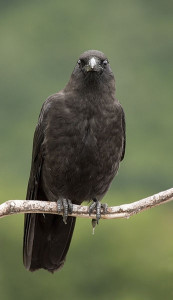
Perhaps most surprising, is that the crows, who are already stealing other’s supplies, are the ones that move the food to other places to hide their own cache. Innocent young birds don’t do this, but then learn from older wiser crows. They understood this new learning without being allowed to find out if they were successful. Therefore, they understand the concept and not just the reward. The experienced birds are extremely flexible in their understanding.
Crows are very advanced in problem solving and using tools. One well-known example involves making a hook shaped wire to grab a bucket with food that was out of reach. Even birds such as rooks, that don’t use tools in the wild, will spontaneously make tools in the laboratory. A recent finding involves understanding water displacement. They will put stones into a pitcher to raise the level of the water so that they can reach the water to drink. They even choose the best stones to build up the level. They understood different choices such as not using fake stones that float. They needed to see the effect of the stone, not just the increase in water level to perform these behaviors.
Only Crows and Humans Can Do It
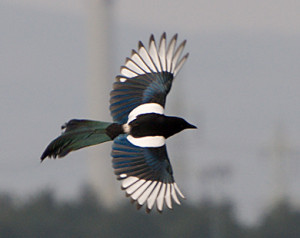 Since we don’t know the inner mental world of crows, we can’t really tell how much they know. Studies have to use behavioral observation. But, all recent studies show that they are one of the most intelligent animals on earth. They share some capacities only with humans. They have some abilities involving flying that are far beyond humans. What is quite remarkable is that crows have these abilities with a much smaller and very different brain.
Since we don’t know the inner mental world of crows, we can’t really tell how much they know. Studies have to use behavioral observation. But, all recent studies show that they are one of the most intelligent animals on earth. They share some capacities only with humans. They have some abilities involving flying that are far beyond humans. What is quite remarkable is that crows have these abilities with a much smaller and very different brain.
Recent research is finding some organizational similarities between crows and humans such as well-connected hubs in the brain. But, the structures are really quite different. Humans have multiple layers in the cortex of related brain regions that can communicate rapidly to analyze complex data. Crows have nuclei of different types that, also, serve the purpose of the cortex with communication between hubs.
It is striking that these two brains developed separately in evolution with no real shared common ancestor for fifty million years. Yet, they have similar circuits involving color, motion and vocal learning that produce very similar advanced behavior.
How do these completely different tracks in evolution produce the same result? Is it not from mental force in evolution leading to the similar sensation and movement and then similar understanding. Is this not another argument for the existence of mind interacting with creatures throughout evolution?

